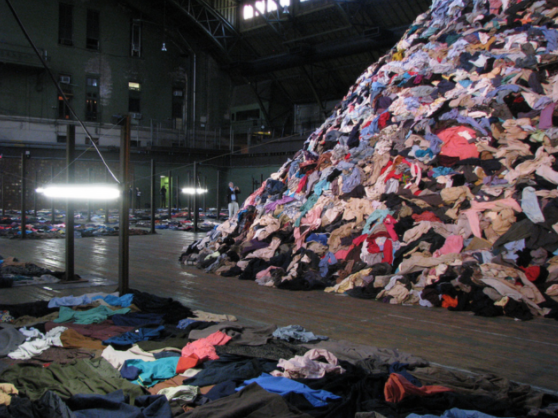The true cost of fast fashion

Photo by Christian Boltanski
October 28, 2021
It’s seven o’clock in the morning, and you’re in a rush to get to school. You dig through your closet, chucking clothes on the ground as you struggle to find anything cute enough to wear. When you arrive home from school, you open the Shein website. As you scroll through it, more and more cute clothes keep popping up.
Because some clothes are as cheap as $1.99, you find yourself adding them to your cart. You text your friend a photo of the clothes and ask if they think you should buy them. They reply saying, “No, don’t support fast fashion.”
Popular clothing stores, such as Shein, H&M, Zara, Boohoo, and Brandy Melville are well known for being trendy, yet affordable companies. The stores produce a massive amount of clothing based on recent celebrity and catwalk trends, and sell it for very low prices. This is called fast fashion.
The idea of fast fashion seems great, seeing as cute, trendy clothes are accessible to everyone regardless of their financial status. However, there are reasons for these low prices, and the question is, do these reasons outweigh the good of fast fashion?
Fast fashion companies are able to price their products so low due to the use of cheap materials. Popular fabrics, including polyester and acrylic, are not sustainable. Polyester, one of the most commonly used fabrics, has massively negative effects on the environment.
Polyester is partially made from oil, which is a major pollutant. Significant amounts of water are also used in the production process and the leftover water is contaminated with chemical dyes, leading to a decrease in clean drinking water and harming plants, wildlife, and even humans. Additionally, polyester can take up to 200 years to break down if put in a landfill.
Acrylic is also widely used in the production of fast fashion clothing, specifically for the warmth it provides. However, the production of the fabric involves chemicals that are hazardous for worker’s health, and even the consumer’s health. Like polyester, acrylic can take up to 200 years to biodegrade. Both fabrics also release microplastics into the environment, which is eminently harmful to marine life.
Fast fashion stores are also able to price their clothing so cheaply because they often exploit children for labor. Because the companies are able to get away with paying their workers an unfair wage, they are able to price their items lower.
Due to the demands for massive amounts of new clothing, the fast fashion industry has become a major employer for children workers. Child workers work in dangerous environments in which they are exposed to chemicals and work with dangerous machinery. This is extremely damaging to both their physical and mental health, but children continue working for these companies in order to support themselves and their families.
Additionally, due to the overproduction and overconsumption of clothing, landfills are filling up with these unsustainable materials after consumers decide the item is no longer in style and rapidly dispose of it.
This disposal of closing is so rapid due to microtrends, or trends that last for only months. Aria Landman, a New York City high school student and fashion lover, says, “I know that with the recent increase in media more people are using Tik Tok. There are a lot more microtrends spreading around [social media] and those lead to a bunch of different fast fashion companies chasing after it.”
Inspired by these trends on social media platforms including Tik Tok, consumers purchase clothes that fit the trend, and once the trend is over, they throw the clothes away. Fast fashion stores like Shein make microtrends easy to participate in by imitating the style and pricing the items for obscenely cheap. “What happens is after a while these things will no longer be in style, so probably most of the clothes will get thrown away and that leads to landfill overflows and whatnot,” adds Landman.
Oftentimes, trendy, affordable clothes from fast fashion stores are hard to resist; however, there are other places to buy them.
Wren Fisher, a sophomore in New York City and someone who has been interested in fashion and clothing for years, is aware of how difficult avoiding fast fashion is. She says, “I shop mostly at thrift stores because it’s much more sustainable but sometimes when I shop at non-thrift stores I always do my research.”
As an alternative to going to a thrift store, apps like Depop and Poshmark, in which users can sell their used clothing for discounted prices, are a great place to find clothes. Even if you want to buy a shirt from Brandy Melville, you can buy it from one of these apps instead by searching for the item you want. By doing so, you are preventing more waste by recycling clothes and at the same time, you are not supporting a fast fashion company. Similar to clothing at thrift stores and online thrift stores like ThredUp, the problem with these apps is that cute clothes can be harder to find, but that’s also what makes thrifting fun.
Not everyone can manage to avoid fast fashion. Due to societal pressures to always look your best and simply the fun of dressing up in a cute outfit, people need clothing, no matter what their budget is. Fast fashion can be an accessible, inexpensive option for clothing, especially if money is an issue.
Andie Hart, a Brooklyn teenager who has been trying her best to avoid fast fashion for years says, “Fast fashion is really cheap and so it can help people who can’t afford to get cute clothes that aren’t designer or really expensive.”
Fast fashion is difficult to avoid. Whether you’re struggling to refrain from buying a trendy top, or you simply cannot afford to shop elsewhere, it is sometimes impossible to fully cut these stores out of your wardrobe. However, when shopping at fast fashion companies, it is important to understand the implications your purchases have on the environment and exploited workers. Landman concludes, “I think that people should try to just limit [fast fashion] because I know that stopping [it] altogether is pretty impossible.”

